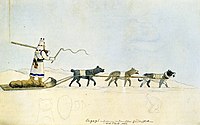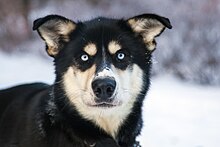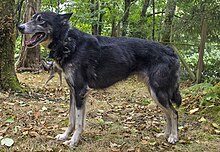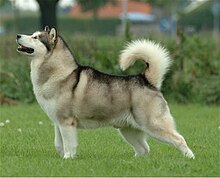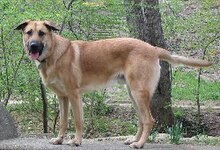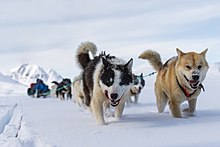
History[edit]
An Indian sled dog team of 3 near Fort Clark, North Dakota, sketched in 1833
Sled dogs are used in Canada, Lapland, Greenland, Siberia, Chukotka, Norway, Sweden, Finland, and Alaska.[1]
Siberia[edit]
A 2017 study showed that 9,000 years ago, the domestic dog was present at what is now Zhokhov Island, Arctic northeastern Siberia, which at that time was connected to the mainland. The dogs were selectively bred as either sled dogs or hunting dogs, implying that a sled dog standard and a hunting dog standard co-existed. The optimal maximum size for a sled dog is 20–25 kg based on thermo-regulation, and the ancient sled dogs were between 16–25 kg. The same standard has been found in the remains of sled dogs from this region 2,000 years ago and in the modern Siberian Husky breed standard. Other dogs were more massive at 30 kg and appear to be dogs that had been crossed with wolves and used for polar bear hunting. At death, the heads of the dogs had been carefully separated from their bodies by humans and was thought to be for ceremonial reasons.[2]
Greenland[edit]
The Greenlandic Inuit have a very long history of using sled dogs and they are still widely used today. As of 2010, some 18,000 Greenland dogs were kept in western Greenland north of the Arctic Circle and in eastern Greenland (because of the effort of maintaining the purity of this culturally important breed, they are the only dogs allowed in these regions) and about half of these were in active use as sled dogs by hunters and fishers.[3] As a result of reduced sea ice (limiting their area of use), increasing use of snowmobiles, increasing dog food prices and disease among some local dog populations, the number has been gradually falling in decades and by 2016 there were 15,000 Greenland dogs. A number of projects have been initiated in an attempt of ensuring that Greenland’s dog sledding culture, knowledge and use are not lost.[4]
The Sirius Patrol, a special forces unit in the Danish military, enforces the sovereignty of the remote unpopulated northeast (essentially equalling the Northeast Greenland National Park) and conduct long-range dog sled patrolling, which also record all sighted wildlife. The patrols averaged 14,876 km (9,244 mi) per year during 1978–1998. By 2011, the Greenland wolf had re-populated eastern Greenland from the National Park in the northeast through following these dog-sled patrols over distances of up to 560 km (350 mi).[5]
North America[edit]
In 2019, a study found that those dogs brought initially into the North American Arctic from northeastern Siberia were later replaced by dogs accompanying the Inuit during their expansion beginning 2,000 years ago. These Inuit dogs were more genetically diverse and more morphologically divergent when compared with the earlier dogs. Today, Arctic sledge dogs are the last descendants in the Americas of this pre-European dog lineage.[6]
Historical references of the dogs and dog harnesses that were used by Native American cultures date back to before European contact.[7] The use of dogs as draft animals was widespread in North America.[7] There were two main kinds of sled dogs; one kind was kept by coastal cultures, and the other kind was kept by interior cultures such as the Athabascan Indians.[7] These interior dogs formed the basis of the Alaskan husky.[7] Russian traders following the Yukon River inland in the mid-1800s acquired sled dogs from the interior villages along the river.[7] The dogs of this area were reputed to be stronger and better at hauling heavy loads than the native Russian sled dogs.[7]
The Alaskan Gold Rush brought renewed interest in the use of sled dogs as transportation.[7] Most gold camps were accessible only by dogsled in the winter.[8] “Everything that moved during the frozen season moved by dog team; prospectors, trappers, doctors, mail, commerce, trade, freighting of supplies … if it needed to move in winter, it was moved by sled dogs.”[7] This, along with the dogs’ use in the exploration of the poles, led to the late 1800s and early 1900s being nicknamed the “Era of the Sled Dog”.[9]
Sled dogs were used to deliver the mail in Alaska during the late 1800s and early 1900s.[10] Alaskan Malamutes were the favored breed, with teams averaging eight to 10 dogs.[10] Dogs were capable of delivering mail in conditions that would stop boats, trains, and horses.[10] Each team hauled between 230 and 320 kilograms (500 and 700 lb) of mail.[10] The mail was stored in waterproofed bags to protect it from the snow.[10] By 1901, dog trails had been established along the entirety of the Yukon River.[10] Mail delivery by dog sled came to an end in 1963 when the last mail carrier to use a dog sled, Chester Noongwook of Savoonga, retired.[10] He was honored by the US Postal Service in a ceremony on St. Lawrence Island in the Bering Sea.[10]
Airplanes took over Alaskan mail delivery in the 1920s and 1930s.[7] In 1924, Carl Ben Eielson flew the first Alaskan airmail delivery.[11] Dog sleds were used to patrol western Alaska during World War II.[11] Highways and trucking in the 40s and 50s, and the snowmobile in the 50s and 60s, contributed to the decline of the working sled dog.[7]
Recreational mushing came into place to maintain the tradition of dog mushing.[7] The desire for larger, stronger, load-pulling dogs changed to one for faster dogs with high endurance used in racing, which caused the dogs to become lighter than they were historically.[7][12] Americans and others living in Alaska then began to import sled dogs from the native tribes of Siberia (which would later evolve and become the Siberian Husky breed) to increase the speed of their own dogs, presenting “a direct contrast to the idea that Russian traders sought heavier draft-type sled dogs from the Interior regions of Alaska and the Yukon less than a century earlier to increase the hauling capacity of their lighter sled dogs.”[7]
Outside of Alaska, dog-drawn carts were used to haul peddler’s wares in cities like New York.[13]
Nome, Alaska and the Iditarod[edit]
In 1925, a massive diphtheria outbreak crippled Nome, Alaska. There was no serum in Nome to treat the people infected by the disease.[11] There was serum in Nenana, but the town was more than 970 kilometres (600 miles) away, and inaccessible except by dog sled.[11] A dog sled relay was set up by the villages between Nenana and Nome, and 20 teams worked together to relay the serum to Nome.[11] The serum reached Nome in six days.[11]
The Iditarod Trail was established on the path between these two towns.[11] It was known as the Iditarod Trail because, at the time, Iditarod was the largest town on the trail.[11] During the 1940s, the trail fell into disuse.[11] However, in 1967, Dorothy Page, who was conducting Alaska’s centennial celebration, ordered 14 kilometres (9 miles) of the trail to be cleared for a dog sled race.[11] In 1972, the US Army performed a survey of the trail, and in 1973 the Iditarod was established by Joe Redington, Sr.[11][14] The race was won by Dick Wilmarth, who took three weeks to complete the race.[11]
The modern Iditarod is a 1,800-kilometre-long (1,100 mi) endurance sled dog race.[14] It usually lasts for ten to eleven days, weather permitting.[14] It begins with a ceremonial start in Anchorage, Alaska on the morning of the first Saturday in March, with mushers running 32 kilometres (20 miles) to Eagle River along the Alaskan Highway, giving spectators a chance to see the dogs and the mushers.[15] The teams are then loaded onto trucks and driven 48 kilometres (30 miles) to Wasilla for the official race start in the afternoon.[15] The race ends when the last musher either drops out of the race or crosses the finish line in Nome.[14] The winner of the race receives a prize of US$50,000.[14] It has been billed as the “World Series of mushing events”[16] and “The Last Great Race on Earth”.[17]
Antarctica[edit]
Roald Amundsen, whose Antarctic expedition was planned around 97 sled dogs
The first Arctic explorers were men with sled dogs.[18] Due to the success of using sled dogs in the Arctic, it was thought they would be helpful in the Antarctic exploration as well, and many explorers made attempts to use them.[18] Sled dogs were used until 1992, when they were banned from Antarctica by the Protocol on Environmental Protection to the Antarctic Treaty[18] over concerns that the dogs might transfer diseases such as canine distemper to the seal population.[19]
Carsten Borchgrevink used sled dogs (Samoyeds) in Antarctica during his Southern Cross Expedition (1898–1900), but it was much colder than expected at Cape Adare.[18] The dogs were used to working on snow, not on ice, in much milder temperatures.[18] The dogs were also inadequately fed, and eventually all of the dogs died.[18]
Erich von Drygalski used sled dogs in his 1901–1903 expedition, and fared much better because his dogs were used to the cold and he hired an experienced dog handler.[18] His dogs were allowed to breed freely and many had to be shot because there was no room on the ship to take them home.[18] Many that were not shot were left behind on the Kerguelen Islands.[18]
Otto Nordenskjold intended to use sled dogs in his 1901–1904 expedition, but all but four of his dogs died on the journey south.[18] He picked up more dogs in the Falklands, but these were all killed upon his arrival by Ole Jonassen‘s huskies, as Ole had not bothered to tether his dogs.[18] These huskies were later able to pull 265 kilograms (584 pounds) over 29 kilometres (18 miles) in three and a half hours.[18]
Robert Falcon Scott brought twenty Samoyeds with him.[18] The dogs struggled under the conditions Scott placed them in, with four dogs pulling heavily loaded sleds through 45-centimetre-deep (18 in) snow with bleeding feet.[18] Scott blamed their failure on rotten dried fish.[18]
Douglas Mawson and Xavier Mertz were part of the Far Eastern Party, a three-man sledging team with Lieutenant B.E.S. Ninnis, to survey King George V Land, Antarctica. On 14 December 1912 Ninnis fell through a snow-covered crevasse along with most of the party’s rations, and was never seen again. Their meagre provisions forced them to eat their remaining dogs on their 315-mile (507 km) return journey. Their meat was tough, stringy and without a vestige of fat. Each animal yielded very little, and the major part was fed to the surviving dogs, which ate the meat, skin and bones until nothing remained. The men also ate the dog’s brains and livers. Unfortunately eating the liver of sled dogs produces the condition hypervitaminosis A because canines have a much higher tolerance for vitamin A than humans do. Mertz suffered a quick deterioration. He developed stomach pains and became incapacitated and incoherent. On 7 January 1913, Mertz died. Mawson continued alone, eventually making it back to camp alive.[20]
Roald Amundsen‘s expedition was planned around 97 sled dogs.[18] On his first try, two of his dogs froze to death in the −56 °C (−69 °F) temperatures.[18] He tried a second time and was successful.[18] Amundsen was covering 27 kilometres (17 miles) a day, with stops every 4.8 kilometres (3 miles) to build a cairn to mark the trail.[18] He had 55 dogs with him, which he culled until he had 14 left when he returned from the pole.[18] On the return trip, a man skied ahead of the dogs and hid meat in the cairns to encourage them to run.[18]
Sled dog breeds[edit]
The original sled dogs were chosen for size, strength and stamina, but modern dogs are bred for speed and endurance [7][12] Most sled dogs weigh around 25 kilograms (55 lb),[21] but they can weigh as little as 16 kilograms (35 lb), and can exceed 32 kilograms (71 lb).[12] Sled dogs have a very efficient gait,[21] and “mushers strive for a well balanced dog team that matches all dogs for both size (approximately the same) and gait (the walking, trotting or running speeds of the dogs as well as the ‘transition speed’ where a dog will switch from one gait to another) so that the entire dog team moves in a similar fashion which increases overall team efficiency.”[12] They can run up to 45 km/h (28 mph).[22] Because of this, sled dogs have very tough, webbed feet with closely spaced toes.[12] Their webbed feet act as snow shoes.[18]
A dog’s fur depends on its use. Freight dogs should have dense, warm coats to hold heat in,[12] and sprint dogs have short coats that let heat out.[1] Most sled dogs have a double coat, with the outer coat keeping snow away from the body, and a waterproof inner coat for insulation.[22] In warm weather, dogs may have problems regulating their body temperature and may overheat.[12] Their tails serve to protect their nose and feet from freezing when the dog is curled up to sleep.[18] They also have a unique arrangement of blood vessels in their legs to help protect against frostbite.[18]
Appetite is a big part of choosing sled dogs; picky dogs off trail may be pickier on the trail.[12] They are fed high-fat diets, and on the trail may eat oily salmon or blubbery sea mammals.[18] Sled dogs also must not be overly aggressive with other dogs.[12]
Breeds[edit]
Alaskan husky[edit]
The most commonly used dog in dog sled racing,[21] the Alaskan husky is a mongrel[7] bred specifically for its performance as a sled dog.[1]
The first dogs arrived in the Americas 12,000 years ago; however, people and their dogs did not settle in the Arctic until the Paleo-Eskimo people 4,500 years ago and then the Thule people 1,000 years ago, both originating from Siberia.[23] In 2015, a study using a number of genetic markers indicated that the Alaskan husky, the Siberian Husky and the Alaskan Malamute share a close genetic relationship between each other and were related to Chukotka sled dogs from Siberia. They were separate from the two Inuit dogs, the Canadian Eskimo Dog and the Greenland dog. In North America, the Siberian Husky and the Alaskan Malamute both had maintained their Siberian lineage and had contributed significantly to the Alaskan husky, which showed evidence of crossing with European dog breeds that was consistent with this breed being created in post-colonial North America. The modern Alaskan husky reflects 100 years or more of crossbreeding with English Pointers, German Shepherd Dogs, and Salukis to improve its performance.[23] Occasionally, Alaskan huskies are referred to as Indian Dogs, because the best ones supposedly come from Native American villages in the Alaskan and Canadian interiors.[1] They typically weigh between 18 and 34 kilograms (40 and 75 lb) and may have dense or sleek fur.[1] Alaskan huskies bear little resemblance to the typical husky breeds they originated from, or to each other.[1]
There are two genetically distinct varieties of the Alaskan husky: a sprinting group and a long-distance group.[9] Alaskan Malamutes and Siberian Huskies contributed the most genetically to the long-distance group, while English Pointers and Salukis contributed the most to the sprinting group.[9] Anatolian Shepherd Dogs contributed a strong work ethic to both varieties.[9] There are many Alaskan huskies that are part Greyhound, which improves their speed.[1]
Alaskan Malamute[edit]
Alaskan Malamutes are large, strong freight-type dogs.[1] They weigh between 36 and 54 kilograms (80 and 120 lb) and have round faces with soft features.[1] Freight dogs are a class of dogs that includes both pedigree and non-pedigree dogs.[1]Alaskan Malamutes are thought to be one of the first domesticated breeds of dogs, originating in the Kotzebue Sound region of Alaska.[24] These dogs are known for their broad chests, thick coats, and tough feet.[1] Speed has little to no value for these dogs – instead, the emphasis is on pulling strength.[1] They are used in expedition and long adventure trips, and for hauling heavy loads.[1]Alaskan Malamutes were the dog of choice for hauling and messenger work in World War II.[24]
Canadian Eskimo Dog[edit]
Also known as the Exquimaux Husky, Esquimaux Dog, and Qimmiq, the Canadian Eskimo Dog has its origins in the aboriginal sled dogs used by the Thule people of Arctic Canada.[25] The breed as it exists today was primarily developed through the work of the Canadian government.[25] It is capable of pulling between 45 and 80 kilograms (99 and 176 lb) per dog for distances between 24 and 113 kilometres (15 and 70 mi).[25] The Canadian Eskimo Dog was also used as a hunting dog, helping Inuit hunters to catch seals, muskoxen, and polar bears.[25]
Chinook[edit]
The Chinook is a rare breed of sled dog developed in New Hampshire in the early 1900s, and is a blend of English Mastiff, Greenland Dog, German Shepherd Dog, and Belgian Shepherd.[26] It is the state dog of New Hampshire and was recognized by the American Kennel Club in the Working Group in 2013.[26] They are described as athletic and “hard bodied” with a “tireless gait”.[26] Their coat color is always tawny, ranging from a pale honey color to reddish-gold.
Greenland Dog[edit]
Eskimo dogs that originated in Greenland, Greenland Dogs are heavy dogs with high endurance but little speed.[1] They are frequently used by people offering dog sled adventures and long expeditions.[1] As of 2016, there were about 15,000 Greenland Dogs living in Greenland, but decades ago the number was significantly higher and projects have been initiated to ensure the survival of the breed.[4] In many regions north of the Arctic Circle in Greenland, they are a primary mode of transportation in the winter.[3][27] Most hunters in Greenland favor dog sled teams over snowmobiles, as the dog sled teams are more reliable.[27]
Samoyed[edit]
The Samoyed was developed by the Samoyede people of Siberia, who used them to herd reindeer and hunt, in addition to hauling sleds.[28] These dogs were so prized, and the people who owned them so dependent upon them for survival, that the dogs were allowed to sleep in the tents with their owners.[28]
Siberian Husky[edit]
Smaller than the similar-appearing Alaskan Malamute, the Siberian Husky pulls more, pound for pound, than a Malamute. Descendants of the sled dogs bred and used by the native Chukchi people of Siberia which were imported to Alaska in the early 1900s, they later became widely bred by recreational mushers and show-dog fanciers in the U.S. and Canada as the Siberian Husky, after the popularity garnered from the 1925 serum run to Nome.[29] Siberians stand 20-23.5 inches, weigh between 35 and 60lbs (35-50 for females, 45-60 for males) [30], and have been selectively bred for both appearance and pulling ability.[1]
Seppala Siberian Sleddog[edit]
Descended primarily from one of the most famous sled dogs, Togo, and named after his musher and breeder, Leonhard Seppala, the Seppala Siberian has become a sought after sled dog line. Like the Siberian Husky, they are descended directly from native Siberian import dogs and thus share a genetic base, but unlike them, have been bred with working ability as a moderately-long-distance sled dog as the only consideration, with no attention given to aesthetic traits or conformation standards. [31]
Other breeds[edit]
Numerous non-sled dog breeds have been used as sled dogs. Poodles,[32] Irish Setters,[1] German Shorthaired Pointers,[1] Labrador Retrievers,[1] Newfoundlands,[10] Chow Chows and St. Bernards[10] have all been used to pull sleds in the past.
